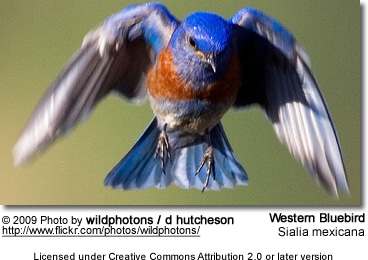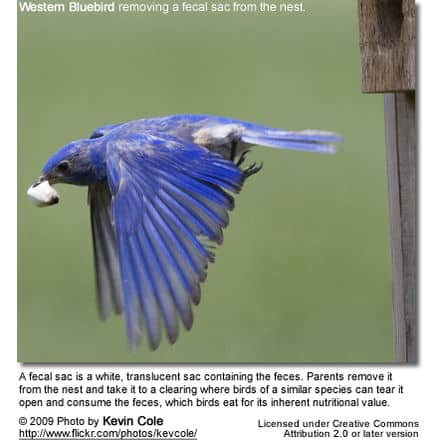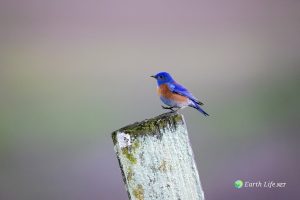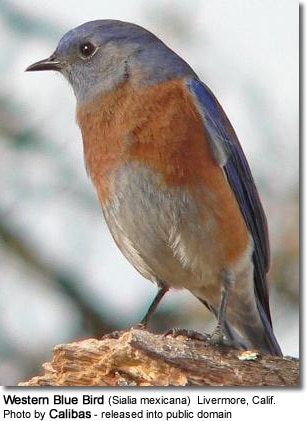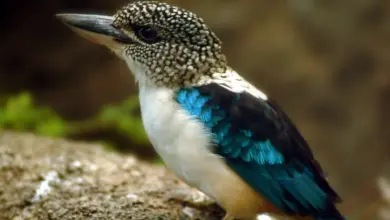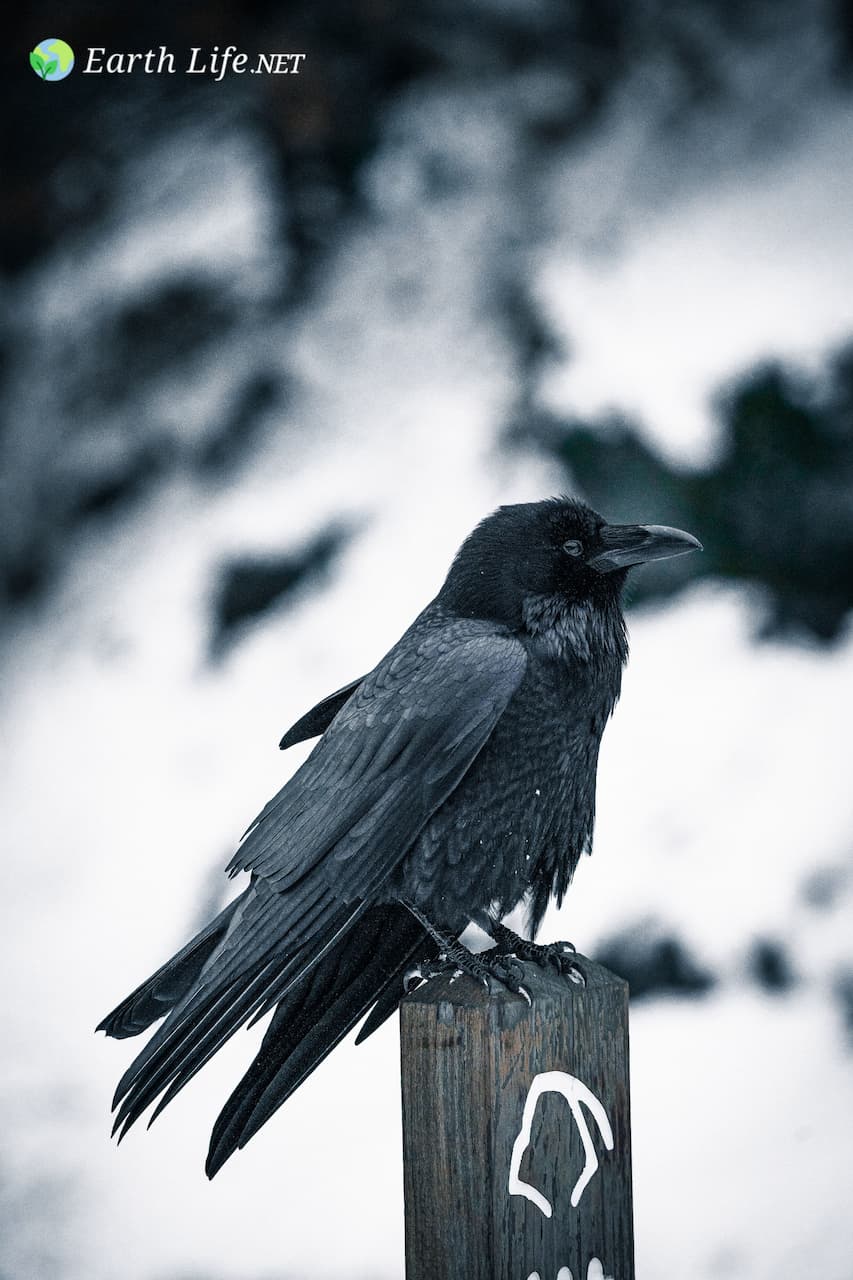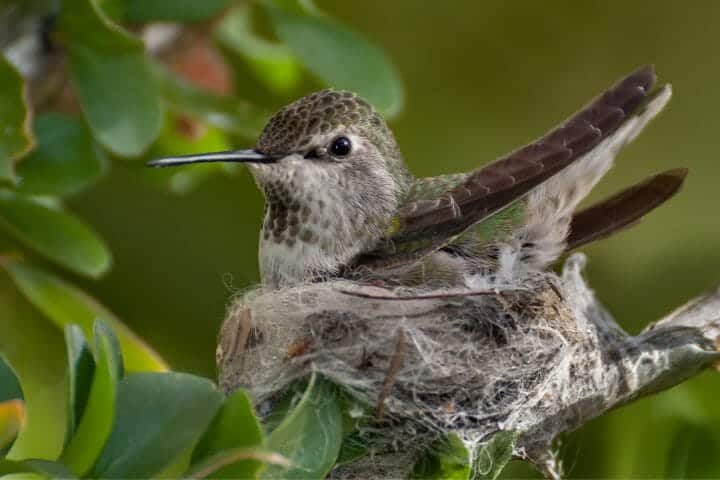Western Bluebirds
Western Bluebirds (Sialia mexicana)
The Western Bluebirds or Mexican Bluebirds (Sialia mexicana mexicana) occur naturally in Northern America. During the breeding season, these bluebirds are typically seen in pairs or
small family groups.
Western Bluebirds or Mexican Bluebirds (Sialia mexicana mexicana)
The Western Bluebirds or Mexican Bluebirds (Sialia mexicana mexicana) occur naturally in Northern America. They are the western counterparts of the more familiar Eastern Bluebirds.
During the breeding season, these bluebirds are typically seen in pairs or small family groups; however, for the rest of the year, these social birds often join large mixed feeding flocks with 100 birds or more. These flocks may include the related Mountain Bluebirds (with which they are known to hybridize), American Robins and Yellow-rumped Warblers, and other birds with similar feeding habits.
When temperatures drop, these birds often use communal roost cavities, such as bird roost boxes, where groups of birds share the same space to keep warm. During the day, these birds are most commonly seen perching on fence posts, signs, or prominent limps as they scan the ground for insect prey.
Nesting Western Bluebirds maintain breeding and feeding territories, and will aggressively defend those. In flight, they may grab the opponent’s legs, and the two birds will tumble to the ground where the fight continues. Males have been seen pinning intruding birds on the ground and jabbing them with their bills.
Western Bluebirds Distribution / Habitat
Western Bluebirds are found in parts of western North America, with a range that stretches from southeastern British Columbia and Alberta in Canada, south into the United States, where they occur in Washington, Idaho, western and south-central Montana, Nevada, Utah, Colorado, west Texas, New Mexico, Arizona and California. They range south into northern Baja California and into the central Mexican states of Michoacan, Puebla, and central Veracruz.
Northern populations migrate south for the winter and those found in southern parts of the range are often resident (non-migratory), except for some seasonal altitudinal movements.
Migrating birds are thought to follow their regular foraging routes.
Western Bluebirds Subspecies and Ranges
- Mexican Bluebird or Western Bluebird (Sialia mexicana mexicana – Swainson, 1832) – Nominate Form
- Range: Central Mexico from Veracruz to northern Puebla and Hidalgo, west to Michoacán and Aguascalientes.
- (Sialia mexicana mexicana [australis] – Nelson, 1903) – Proposed race. Not universally recognized.
- Range: Southern plateau of Mexico, from Jalisco to Morelos, Puebla and Veracruz.
- California Bluebird or Western Bluebird (Sialia mexicana occidentalis – Townsend, JK, 1837)
- Range: Southwestern Canada – from southern British Columbia south to western Nevada and southern California to northern Baja California in northwestern Mexico.
- San Pedro (Western) Bluebird (Sialia mexicana occidentalis [anabelae] – Anthony, 1889)
- Range: Mountains of northern Baja California in Sierra Juárez and San Pedro Mártir.
- Chestnut-backed Bluebird (Sialia mexicana bairdi – Ridgway, 1894)
- Range: Interior western United States south to Sonora and northwestern Chihuahua in northwestern Mexico
Western Bluebird (amabilis) (Sialia mexicana amabilis – Moore, RT, 1939)
- Range: Northwestern Mexico in the Sierra Madre Occidental- from southeastern Chihuahua to northwestern Zacatecas
- Western Bluebird (jacoti) (Sialia mexicana jacoti – Phillips, AR, 1991)
- Range: the Davis Mountains in southern Texas (southern USA) and the San Luis Mountains in northeastern Mexico.
- Western Bluebird (nelsoni) (Sialia mexicana nelsoni – Phillips, AR, 1991)
- Range: Northeastern and central Mexico in northern Coahuila to western San Luis Potosí, northern Guanajuato, and northeastern Jalisco.
Western Bluebirds Description
Western Bluebirds Size
- Small thrushes. Larger than a sparrow; about two-thirds the size of an American Robin
- Length (including tail): 6.3 – 7.5 inches (16 – 19 cm)
- Wingspan: 12 – 13 inches (30 – 33 cm)
- Weight: 0.8 – 1.1 oz (23 – 31 g)
Western Bluebirds Plumage Details / Adults
Males:
- Blue throat
- Deep, glossy-blue back with rusty-orange markings extending from the chest onto the upper back (not apparent in all males)
- Cobalt-blue head, chin and throat
- Many (but not all) have rusty-red shoulders
- Bright blue wings and tail
- Grey-blue abdomen and undertail feathers
Females:
- Duller plumage
- Grey-buff throat
- Pale blue head
- Brown-grey back
- Grey-blue wings, tail and rump
- Pale chestnut / orange-colored chest, sides and flanks
- Grey-white undertail feathers.
- Distinctive white eye rings.
- Brown abdomen, turning whitish towards the lower belly
Other Physical Details
- Large rounded head
- Fairly small black, straight, thin bill
- Large, dark eyes
- Stocky build
- Long wings
- Fairly short tail
- Blackish legs and feet
Western Bluebirds Juvenile Description
- Juveniles have a mostly brown-grey plumage with heavy white or buff spotting. There is a blue wash on the wings and tail.
- As they grow older, the blue color becomes more prominent and the spotting disappears.
Similar Species To Western Bluebirds
- The male Mountain Bluebird has an all-blue plumage that is lighter both above and below. The female is greyer overall and either lacks the rusty wash on the grey chest or these markings are greatly reduced. The bill is slimmer than that of the Western Bluebird.
- Male Eastern Bluebirds have rusty-orange throats (white in the females); the abdomen is white and the male’s back is entirely blue. The Western Bluebirds have more extensive blue coloration. The Eastern Bluebirds occur in the eastern USA and the Western Bluebird in the western USA, with only a small overlap.
- Male Lazuli Buntings are smaller than Western Bluebirds. They have prominent white wing bars and thick bills (indicative of their seed-eating habits).
- The Western Scrub-Jays and Steller’s Jay could only be confused with the Bluebirds because of their blue plumage details, but the plumage is differently patterned; the jays are much larger and noisier, and have longer tails, heavier bills, and lack any rusty-orangy coloration.
Western Bluebirds Diet / Feeding
- During the spring and summer months, adult bluebirds mostly feed on insects and other invertebrates, including spiders, flies, crickets, grasshoppers, bees, wasps, sowbugs, beetles, termites, snails, worms, caterpillars, ants, and pillbugs. These “perch-foragers” look for prey from perches and then drop down on the ground to capture them and return to their perch to feed. They will also catch insects in flight. Animal foods (insects, etc.) make up about 82% of their total diet. These insect-eating birds are helpful in controlling insect populations without the use of toxic pesticides.
- During the winter – when insects are less available – their diet is primarily made up of wild fruit, and plants, such as mistletoe berries (Phoradendron) and elderberries (Sambucus ssp), which are their main winter food items. They will also take blackberries, bayberries, pokeberries, cherries, raspberries, honeysuckle, dogwood, red cedar, wild grapes, and figs. They will supplement their plant-based diet with insects, as available. To a lesser degree, they will feed on seeds and grain, which are not part of their typical diet.
- Nestlings are fed: various insects, including grasshoppers, crickets, caterpillars, beetles, bugs, and spiders.
- Outside the breeding season, these social birds may be seen foraging in flocks.
Western Bluebirds Breeding / Nesting
Most breeding occurs between May to July.
Western Bluebirds are monogamous, although instances of extra-pair copulation are regularly reported. In fact, according to genetic studies, as much as 45 percent of all nests contain one or more chicks that are not the resident males’ offspring.
They are also cooperative breeders, which means that birds other than the parents help raise the young. These are often referred to as “nest helpers.” These can be the independent young from prior clutches, adult pairs, or often other unmated adult males. There have also been reports of birds of different species helping them. For example, Violet-green Swallows have been seen feeding the young and defending the nests of Western Bluebirds.
At the onset of the breeding season, the male will perform a courtship display that includes exaggerated flights and offering food to potential females.
Once a pair bond has been made, the pair will search for a nest site together.
These cavity nesters will inspect holes in trees, which often are abandoned woodpecker nests. They will also nest in dirt banks and hollow fence posts. In some instances, they have made their nests in mailboxes or protected areas in buildings/structures. If available, they may also take advantage of artificial birdhouses.
Nests are usually 2 – 50 feet (0.6 – 15 meters) above the ground.
Once a suitable site has been identified, both the male and the female will construct a nest using grasses, weeds, roots, twigs, pine needles, and other materials found in their environment.
The average clutch size consists of 2 -8 eggs (typically 4 or 5). The smooth, oval eggs range in color from a pale blue to bluish-white or sometimes are entirely white. Each egg measures about 0.6 – 0.8 inches (16.2 – 20.8 mm) and has a smooth and glossy shell.
The female alone incubates the eggs for 12 – 18 days (most often 14). The male guards the nest and takes food to the brooding female. The pink hatchlings are only covered with a sparse grey down. They are blind and helpless. Both parents raise the chicks. The young fledge when they are about 18 to 25 days old, but their parents continue to feed them for up to 30 days after hatching.
As soon as the first brood has fledged, the female will typically start on the next clutch. She may produce up to three broods in a year if conditions are favorable.
Western Bluebirds Calls / Vocalizations / Sounds / Video
Calls:” Kew-kew” and “Che-check“, often repeated several times.
Western Bluebird Video
Western Bluebirds Alternate (Global) Names
Chinese: ??? … Czech: Salašník západní, Sialie západní … Danish: Vestlig Sialia … Dutch: Blauwkeelsialia, Westelijke Bluebird … German: Blaukehl-Hüttensänger … Finnish: Purppurasinikka … French: Merle bleu à dos marron, Merle bleu du Mexique, Merle-bleu de l’Ouest … Hungarian: mexikói kékmadár … Italian: Azzurrino occidentale, Uccello azzurro occidentale … Japanese: chagataruritsugumi, chakataruritsugumi … Norwegian: Vestblåfugl … Polish: blekitnik meksykanski, b??kitnik meksyka?ski … Russian: ?? … Slovak: salašník hájový … Spanish: Azulejo Garganta Azul, Azulejo gorjiazul, Azulejo Occidental, Azulillo de Garganta Azul … Swedish: Västsialia
Western Bluebirds Life Cycle
The oldest known Western Bluebird was 8 years and 8 months old. However, most birds don’t make it through the first year due to harsh environmental conditions during the nesting period to some extent, but primarily they fall victim to predators, such as cats, chipmunks, squirrels, deer mice, raccoons, and larger birds.
They reach reproductive age when they are about one year old.
Other Web Resources
- Attracting Bluebirds to your Garden
- Bluebird Information
- Photos of the Various Bluebird Species for Identification
Western Bluebirds Conservation Status and Measures
Even though Western Bluebirds are still numerous at this time, population declines have been noted in some areas, specifically in Oregon, Utah, Washington, California, New Mexico (USA), and British Columbia (Canada). Western Bluebirds are protected under the US Migratory Bird Treaty Act. The declines throughout much of their territory are caused by a combination of the below …
- Competition for nesting cavities and food with other, more aggressive birds, such as swallows, sparrows, starlings, wrens, woodpeckers, and flycatchers. House sparrows, in particular, are known for attacking Western Bluebirds for their nests, either alone or in groups.
- Destruction of their natural habitat: These forest-living species rely on suitable trees for nesting. However, increased logging, the suppression of natural forest fires, and the removal of dead trees have led to a reduction in suitable nesting sites.
- Pesticides: Both reducing their natural food sources as well as resulting in poisoning of these birds
Conservation groups and private parties successfully organized activities to stop the decline – the most successful measure turned out to be …
Artificial Bluebird Nesting Boxes: Bluebird trails were successfully organized during which lines of bluebird houses were put up, monitored, and maintained by conservation groups as well as by concerned citizens.
It was found that Western Bluebirds more successfully raised chicks in nest boxes than in natural cavities. Breeding pairs can start nesting earlier and the predation rates on the eggs and chicks are generally lower; hence resulting in more young surviving to fledge.
Species Research by Sibylle Johnson
Please Note: The articles or images on this page are the sole property of the authors or photographers. Please contact them directly with respect to any copyright or licensing questions.

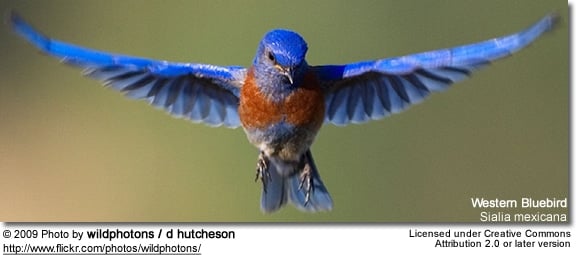
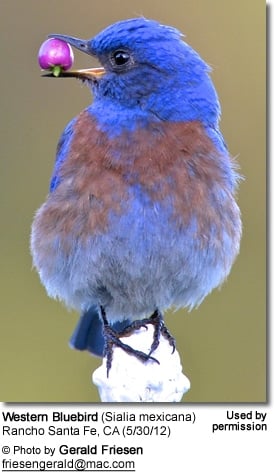
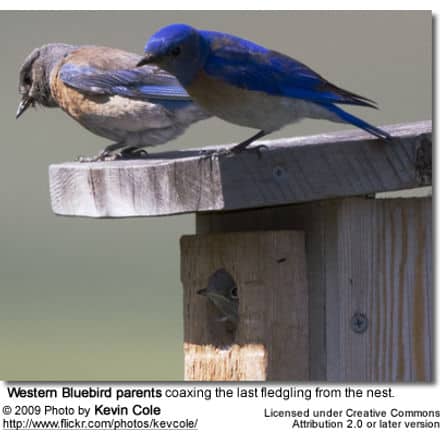 Western Bluebird (amabilis) (Sialia mexicana amabilis – Moore, RT, 1939)
Western Bluebird (amabilis) (Sialia mexicana amabilis – Moore, RT, 1939)
